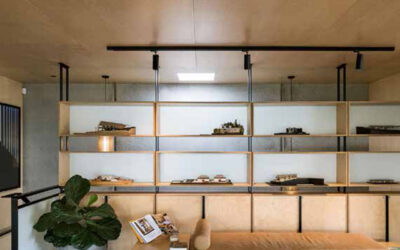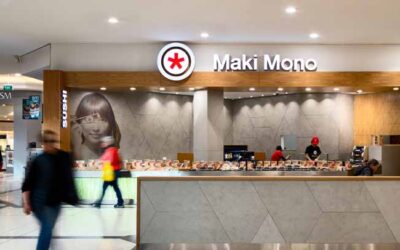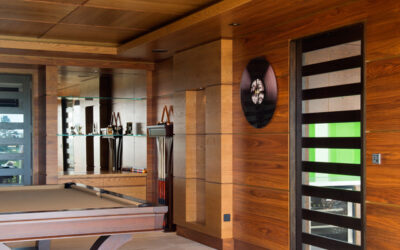Fiber-reinforced plastic (FPR) panels are a preferred wall and ceiling solution for commercial kitchens, restrooms, hospitals, and other environments where durability, hygeine, and resistance to moisture and chemicals are critical. Understanding how to install FPR panels correctly is essential to ensure a long-lasting, seamless finish that stands up to the demands of these high traffic spaces.
While traditional methods such as adhesive or mechanical fasteners are commonly used, Fastmount’s concealed panel mounting systems offer a modern alternative, delivering precise alignment, effortless removability for maintenance, and a flawless appearance.
What is FRP paneling?
FRP panels, sometimes referred to as glassfiber reinforced plastic (GRP) panels, are composite building materials made by combining strong fiberglass strands with a synthetic plastic resin, which is then heated and formed into thin panels. The fusion results in panels that are both lightweight and exceptionally strong, offering a smooth, non-porous surface that’s easy to clean and resistant to stains, mold, and mildew.
Properties of FRP panels
FRP panels are chosen due to several characteristics that make them stand out in demanding environments:
Lightweight yet strong: FRP panels have a high strength-to-weight ratio, making them easy to handle and install without sacrificing durability.
Corrosion and chemical resistance: Unlike metal or wood, FRP doesn’t corrode, rust or rot. It remains unaffected by moisture, chemicals, and cleaning agents, even in harsh industrial or marine settings.
Impact and fatigue resistance: These panels can withstand impacts and repeated use, maintaining their integrity over time.
Thermal and electrical insulation: FRP is non-conductive and offers excellent thermal insulation, making it suitable for environments where temperature and safety are concerns.
Low maintenance: The durability and resistance to environmental factors mean FRP panels require minimal upkeep, reducing replacement costs.
Versatility in design: FRP can be molded into various shapes, textures, and colors to suit different architectural and functional requirements.
Common FRP applications
FRP paneling is widely used across a range of industries and environments:
Commercial kitchens and food processing facilities: Provides a hygienic, easy to clean surface that resists bacteria, mold, and harsh cleaning chemicals.
Restrooms: Ensures sanitary conditions and meets strict health regulations.
Industrial and manufacturing spaces: Used for wall and ceiling paneling, machine enclosures, and tank linings due to its strength and corrosion resistance.
Marine transportation: Ideal for docks, decks, and infrastructure exposed to saltwater and weather extremes.
Architectural and modular construction: Applied in offices, flooring, and stair treads for its durability and design flexibility.
Agricultural, laboratory, and recreational facilities: Chosen for environments where cleanliness, impact resistance, and ease of maintenance are critical.
Traditional methods for how to apply FRP panels and their limitations
When considering how to apply FRP panels, most installers rely on traditional methods such as adhesive (glue-based) installation, mechanical fasteners, or a combination of both. While these approaches are common, each comes with its own set of challenges and potential drawbacks.

How to install FRP paneling using adhesives
Adhesive installation is one of the most widely used methods for attaching FRP panels to walls and ceilings. The process involves spreading a specially formulated FRP adhesive across the entire back of the panel, and then pressing the panel onto a properly prepared substrate. This method is popular for its ability to create a smooth, seamless appearance without visible fasteners.
Limitations of adhesive installation of FRP panels
Surface preparation: The substrate must be clean, dry, and free from dust, grease, and any loose material to ensure proper adhesion. Any unevenness or debris can prevent a secure bond, leading to weak spots or bubbling.
Adhesive compatibility: Not all adhesives are suitable for FRP panels. Using the wrong type can result in weak bonding orpanel failure, especially on non-porous surfaces like tile or metal.
Time sensitivity: Adhesive must be applied and panels positioned within the manufacturer’s recommended time. Delays can result in poor bonding and installation issues.
Expansion and contraction: FRP panels naturally expand and contract with temperature and humidity changes. If panels are installed without adequate spacing or if the adhesive is applied unevenly, bulging, buckling or panel separation can occur.
Labor intensive: Proper adhesive installation often requires two installers and careful rolling to remove air pockets, making the process time consuming and prone to errors such as misalignment.
Difficult repairs: Once installed, panels adhered with glue are difficult to remove for maintenance or repairs without damaging the substrate or the panel itself.
How to attach FRP panels with mechanical fastening
Mechanical fastening uses screws, rivets, or nylon drive rivets to secure FRP panels directly to the substrate. This method is often used when installing over uneven surfaces, concrete, or in environments where adhesives may not cure properly.

Limitations of mechanical fastening installation of FRP panels
Potential for damage: Drilling holes and inserting fasteners can create stress concentrations in the FRP, leading to cracks, or weakening of the panel material.
Aesthetic concerns: Exposed fasteners can detract from the clean, seamless look that FRP panels are known for, and may collect dirt or moisture over time.
Movement issues: Improper fastening can restrict panel movement, resulting in buckling or bulging as the panels expand and contract.
Maintenance challenges: Although panels can be removed by unscrewing fasteners, each time a screw is inserted or removed, it can cause micro-damage to the composite material. Over time, this can lead to reduced retention strength, making the panel less secure.
Time and labor: Installing each panel requires precise measuring, drilling, and fastening which is time consuming and increases overall installation costs.
The benefit of using Fastmount to install FRP panels
When considering how to install FRP panels, the choice of mounting system can dramatically impact the quality, appearance, and long term performance of your project. Fastmount’s concealed panel mounting system offers a range of advantages over traditional adhesive or mechanical fastening methods, making it the preferred solution for environments where durability and easy maintenance are paramount.
Perfect alignment when installing FRP panels
Fastmount’s unique Center Point marking tool ensures panels are installed with perfect alignment. This system allows you to precisely mark and drill clip positions, reducing installation errors and guaranteeing a professional finish, even on large or complex walls.
Installing FRP panels easily and efficiently
Fastmount clips are designed for straightforward installation. Panels can be pre-drilled and prepared off-site, minimizing on-site labor, reducing the risk of panel damage, and speeding up the overall installation process.
A seamless look when attaching FRP panels
Unlike traditional screws or rivets, Fastmount’s hidden clips are completely concealed once installed. This delivers a smooth, uninterrupted surface, ideal for environments where hygiene, aesthetics, abd easy cleaning are essential.
FRP panel installation that’s removable
Panels mounted with Fastmount can be removed and refitted in any sequence, as often as needed without damaging the panel or substrate. This is a major advantage for maintenance, repairs, or access to services hidden behind panels.
FRP paneling that allows for movement
Fastmount’s engineering-grade clips allow for panel flex and movement, accommodating the natural expansion and contraction of FRP panels due to temperature or humidity changes. This helps prevent buckling, bulging or panel separation over time.
Safe and secure FRP panel installation
Fastmount’s clips are precision molded for strength and reliability, providing a secure hold for FRP panels. The system is trusted by architects, designers, and installers worldwide for its proven performance in demanding environments.
How to install FRP paneling using Fastmount’s innovative fastening system
Fastmount’s concealed Standard Range clip system offers a modern, efficient, and professional solution for installing FRP panels in commercial, architectural, and marine settings.
Equipment and tools needed
- Fastmount Standard Range clips (PC-F1A and PC-M1B)
- Fastmount installation tools (CT-07, CT-09, CT-10, CP-01ST)
- 5mm tile packers or spacers (optional)
- Fastmount Layout Guide TD-02
- FRP panels – 6mm (approx a quarter inch) thickness recommended, and suitable substrate
Installing female clips
- Using the Fastmount Layout Guide (TD-02 unless another guide is more suited to your project), mark the location of the female clips (PC-F1A) on the substrate, spacing them evenly for strength and support.
- Drill a 16.8mm (approx 21/32 inch) hole at each marked location using the CT-07 drill bit.
- Insert the female clip into the hole and screw it into the substrate until flush with the surface for a seamless finish.
Installer’s tip: Use low drill RPM when installing to avoid damaging the substrate.
- Insert CP-01ST into all female clips.
- Align the FRP panel into position and press firmly so the center points mark the corresponding locations on the back of the panel.
- Remove center points from female clips.
Installing male clips and attaching panel
- Using Fastmount’s CT-09 drill bit, drill a 10mm (approx 25/64 inch) hole at each marked point on the back of the FRP panel to the recommended depth for the male PC-M1B clip.
- Use CT-10 to install the male clips into the drilled holes in the panel.
- Align the FRP panel with the installed clips on the substrate.
- Press the panel firmly until the clips engage, securing the panel in place.
- Check the alignment of all panels and make any necessary adjustments.
You can watch the installation process via this video.
See attachment of Standard Range clips
Installing FRP panels with a professional finish for lasting results
Mastering how to install FRP panels with Fastmount’s concealed system delivers more than a professional look – it ensures ongoing access, straightforward maintenance, and reliable performance even in the most demanding environments. By following the guide above, you can streamline installation, maintain hygiene standards, and achieve a seamless result. For any project where durability, efficiency, and aesthetics matter, Fastmount stands out as the preferred solution for attaching FRP panels.
Other resources
Explore Fastmount’s entire range of clips



